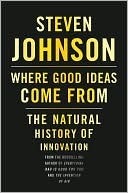More on this book
Community
Kindle Notes & Highlights
Kleiber’s law proved that as life gets bigger, it slows down. But West’s model demonstrated one crucial way in which human-built cities broke from the patterns of biological life: as cities get bigger, they generate ideas at a faster clip. This is what we call “superlinear scaling”: if creativity scaled with size in a straight, linear fashion, you would of course find more patents and inventions in a larger city, but the number of patents and inventions per capita would be stable.
In the mid-1980s, a number of influential media and technology executives, along with a few visionary politicians, had the eminently good idea that it was time to upgrade the video quality of broadcast television. Speeches were delivered, committees formed, experimental prototypes built, but it wasn’t until July 23, 1996, that a Raleigh, North Carolina, CBS affiliate initiated the first public transmission of an HDTV signal. Like the Tournament of Roses footage, though, there were no ordinary consumers with sets capable of displaying its “wizardry.”1 A handful of broadcasters began
...more
Call it the 10/10 rule: a decade to build the new platform, and a decade for it to find a mass audience.
Good ideas are not conjured out of thin air; they are built out of a collection of existing parts, the composition of which expands (and, occasionally, contracts) over time.
The trick is to figure out ways to explore the edges of possibility that surround you. This can be as simple as changing the physical environment you work in, or cultivating a specific kind of social network, or maintaining certain habits in the way you seek out and store information.
The simplest way to answer it is this: innovative environments are better at helping their inhabitants explore the adjacent possible, because they expose a wide and diverse sample of spare parts—mechanical or conceptual—and they encourage novel ways of recombining those parts.
The trick to having good ideas is not to sit around in glorious isolation and try to think big thoughts. The trick is to get more parts on the table.
to make your mind more innovative, you have to place it inside environments that share that same network signature: networks of ideas or people that mimic the neural networks of a mind exploring the boundaries of the adjacent possible.
This is not the wisdom of the crowd, but the wisdom of someone in the crowd. It’s not that the network itself is smart; it’s that the individuals get smarter because they’re connected to the network.
If you looked at the map of idea formation that Dunbar created, the ground zero of innovation was not the microscope. It was the conference table.
Dunbar’s research suggests one vaguely reassuring thought: even with all the advanced technology of a leading molecular biology lab, the most productive tool for generating good ideas remains a circle of humans at a table, talking shop.
Sustaining the slow hunch is less a matter of perspiration than of cultivation.
So part of the secret of hunch cultivation is simple: write everything down.
He needed a work environment that carved out a space for slow hunches, cordoned off from all the immediate dictates of the day’s agenda. And he needed information networks that let those hunches travel to other minds, where they could be augmented and polished.


